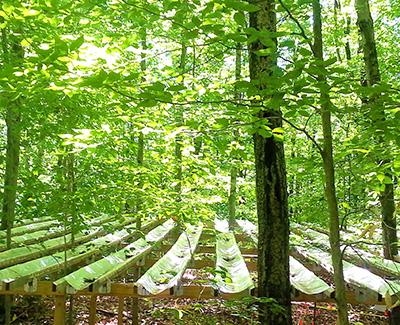Northern Forest DroughtNet: A New Framework to Understand Impacts of Precipitation Change on the Northern Forest Ecosystem

One of the ways that climate change is likely to affect the Northern Forest region is through increased frequency and severity of drought events, such as the extreme drought affecting much of New England in 2016. NSRC researchers created a collaborative network of scientists and stakeholders, Northern Forest DroughtNet, to design a relatively cost efficient and low-tech infrastructure and measurement protocol for conducting throughfall (rainfall coming through the forest canopy) removal experiments in forested ecosystems.
Researchers implemented this prototype drought experiment in a young red maple, beech, birch forest at Hubbard Brook Experimental Forest in New Hampshire. Wooden structures with plastic troughs funneled approximately 50% of incoming throughfall from two 15 x 15 foot plots, to simulate a 1-in-100-year extreme drought. Researchers collected measurements prior to treatment and 3 years post-treatment, including tree growth, soil respiration, root production, and physiological responses. Results suggest that red maple was relatively insensitive to both natural and simulated drought; however, more long-term data are required to confirm these preliminary findings and to compare with other tree species and forest types.
A second drought experiment in a white pine-red oak forest in Durham, NH, showed that unlike red maple, both white pine and red oak displayed high sensitivity to drought, yet the two species also had very different physiological adaptations to moisture stress. These diverging results highlight the importance of understanding how different tree species and forest ecosystems differ in their drought responses and adaptations in order to improve predictions of future forest change and develop effective forest management strategies.
